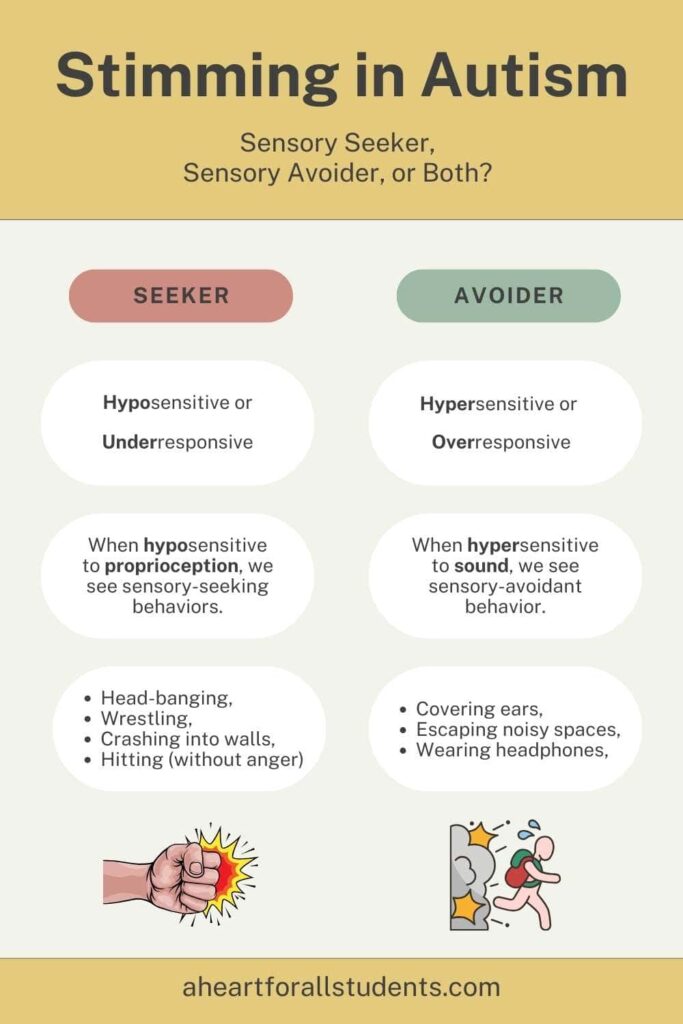Stimming refers to repetitive, self-stimulating, sensory-seeking behavior commonly seen in Autistic kids and adults. Those in the autistic community describe stimming as,
An adaptive mechanism that helps them to soothe or communicate intense emotions or thoughts.
Some of the most visible autistic stimming behaviors include:
- Spinning
- Jumping
- Hand flapping
- Toe walking
- Repeating phrases or movie lines
- Echolalia
Stimming is not exclusive to autism. Many with ADHD stim, and all people stim at times. However, a primary autistic trait is high levels of intense sensory experiences. Because of this, stimming is more commonly seen in autism.

Stimming is Universal
Here’s a list of self-stimulatory behaviors you may relate to. As you read these questions, consider how commonly you see or engage in these behaviors.
- Do you sway side-to-side even without a baby in your arms?
- When you’re nervous, do you pace back and forth?
- Twirl your hair?
- Bob your knee up and down (when seated) when feeling anxious or excited?
- What about the subtle way you clench your teeth when you’re trying to focus?
- Take a hot bath to calm down?
- Listen to music to get through your workout?
- Listening to upbeat music supports dopamine production.
These are all repetitive movements or self-stim behaviors.
5 Reasons Behind Stimming
Like neurotypical people, Autistic individuals, and those with ADHD, stim for many reasons. Some reasons why neurodivergent people stim may include the following.
- Meet sensory needs
- Emotionally regulate
- Support focus and attention
- Calm down or relieve stress
- For fun and enjoyment
Today, we’ll dive into these reasons behind stimming so we can better support our neurodivergent selves and children.

One Stim Behavior: Many Possible Needs
Stimming behaviors will meet different needs for different people at different times. For example, a common stim is pacing back and forth.
Pacing is a common stim behavior we engage in when feeling nervous. It’s a great way to release excess energy for sure.
However, pacing can also meet the need to increase arousal level or focus. Pacing back and forth is an automatic behavior that helps one increase attention and focus through vestibular sensory input.
Awareness Changes Everything
As a parent, understanding the possible reasons behind your autistic child’s self-stimulatory behaviors is energy well spent. And as neurodivergent adults, it’s just as important to recognize and understand your stimming behaviors.

Doing so can help you better support the underlying needs behind them. Plus, understanding the root issues can help you make a better-informed decision when purchasing stim toys or other supports.
1. Meet Sensory Needs
We all have sensory systems that receive and process information from the outside world. However, autistic individuals often have intense sensory experiences that can lead to sensory overwhelm. This is also common for those of us with an ADHD brain.
Stims can meet many sensory needs.
- Visual,
- Auditory,
- Tactile,
- Smell,
- Taste,
- Vestibular,
- Proprioceptive
Stimming behaviors may occur to regulate sensory overwhelm.
Hyposensitive vs Hypersensitive
Two terms are used to indicate the intensity level at which the brain receives types of sensory information.
- Hyposensitive
- Underresponsive
- Sensory seeker
- Hypersensitive
- Over-responsive
- Sensory avoider
Let’s look at these terms to better choose the right stim toys for autism and other sensory issues.

Autism Hyposensitivity Stimming Example
For example, an autistic child may be hyposensitive to proprioceptive input. (The proprioceptive system needs deep pressure to release serotonin and other calming chemicals.)
When hyposensitive to proprioception, we see sensory-seeking behaviors. For example,
- Head-banging
- Wrestling
- Or other large whole-body movements
- Hitting or slapping people
- When not angry
If you notice these behaviors, understand that the brain is seeking the intense levels of deep pressure it needs. There is purpose behind this type of stimming. Squeezing stress balls is one way to meet this type of need while also getting some stress relief.
Proprioceptive Sensory Seeking
In this quick tutorial, I share some common behaviors that are often rooted in sensory needs. Then, I tell you how to help.
Hypersensitivity in Autism Example
At the same time, that same child can be hypersensitive to sound. As such, they’d also be a sensory avoider. Here’s a classic example of sensory avoidance in autism.
During a fireworks show, a child experiences sensory overload in response to the loud noise. She begins shrieking or pacing back and forth with her hands over her ears in overwhelm.
Labeling this child’s stim response as non-purposeful is insensitive and cruel. Noise-canceling headphones can help block out intense noise and prevent sensory overstimulation.
Sensory Processing Disorder
If you’ve worked with an occupational therapist, you may have heard the term sensory integration dysfunction. Based on the work of the late Dr. Jean Ayers, sensory integration describes how the brain processes and responds to various sensory inputs.
Sensory Integration Dysfunction is commonly referred to as sensory processing disorder (SPD), and sensory processing dysfunction.
2. Emotional Regulation
Stimming behaviors can be also rooted in a need to emotionally regulate. Emotional regulation is when a person regulates one’s internal experiences and emotions to fit the environment.
Ever feel stressed because the TV is blaring, the house is a mess, and your to-do list is a mile long? Me too!
Depending upon your capacity, your self-regulation strategy could look a few different ways. You may…
- Escape to your room to breathe deeply
- Repetitive behavior
- Inhale a handful of chocolate chips from the pantry
- Wait… is that just me?
- Start clenching your fists or jaw to prevent yourself from losing it
Whatever the strategy, you often unknowingly engage in some behavior to regulate your emotions.
Hand Flapping
When an autistic child flaps her hands in excitement, that stim is like when you jump up and down at a concert. The autistic child, like you, is regulating or processing emotions through repetitive behavior (clapping or jumping).
3. Improve Focus and Attention

Many neurodivergent people including those with ADHD may stim to regulate attention or increase focus. Commonly neurodivergent children engage in sensory-seeking behavior to increase attention. For example,
- Swinging
- Flipping
- Hanging upside down
- Bouncing
- Repeatedly banging into the back of their seat
This type of repetitive behavior provides vestibular sensory input. Vestibular input is related to changes in head position and releases histamine, a neurotransmitter that increases alertness levels.
4. Relieve Stress and Find Calm

Stimming behaviors can also be rooted in a need to relieve stress and create calm. When the nervous system becomes overwhelmed, stimming behaviors often increase to self-regulate. Some stress-relieving stimming activities include:
- Biting nails
- Skin picking
- Sitting on hands
- Singing songs
- Staring at moving objects
- Playing with different types of fabrics
In truth, stimming activities will have different purposes for different people at different times. Ultimately, stimming is a coping strategy to serve the well-being of the person.
5. Stimming for Fun and Enjoyment

Many autistic children and adults stim for pleasure and joy. Hand flapping can be a way to express joy, just as it can calm an anxious mind. In the end, becoming attuned to the reasons behind our kids’ behaviors (and our own) can be so helpful.
25 Stimming Behaviors
Here’s a list of 25 common stimming behaviors. This list is not exhaustive but can guide you to understand better stimming in autism. Stimming behaviors should not be extinguished or suppressed unless harmful. Work with a neurodiversity-affirming occupational therapist to learn more about your child’s sensory and stimming needs.
- Singing a song over and over again
- This can be a sign of Gestalt Language Processing
- Listening to a song on repeat
- Repeating phrases or words
- Clearing throat
- Biting nails
- Scratching skin
- Jumping up and down
- Rubbing fingers on fabrics
- Twirling hair
- Chewing on hair or fabric
- Grinding teeth
- Humming
- Cracking knuckles
- Coughing in a pattern
- Head banging
- Spinning in a chair
- Twirling
- Pacing
- Rocking
- Bouncing into the back of the couch repeatedly
- Flicking light switches on and off
- Tapping fingers
- Organizing or lining up toys or objects
- Skin Picking
- Fidgeting
Recap: Stimming in Autism and ADHD
Stimming is short for self-stimulating repetitive behavior. Like neurotypical people, many neurodivergent children and adults, (ADHD and autism), stim for different reasons. Stimming is most often a healthy coping mechanism unless the stim causes harm to the person or others.
So, Friend. What stimming behaviors are common in your ADHD or autistic family?
Up Next:
25 Stim Toys for Autism and ADHD Sensory Needs
31 Best Autism Calming Strategies That Can Work for All!
25 Sensory Activities to Support an Autistic Teenager

About the Author:
Lindsay is a trauma-informed educator with a Master’s Degree in Teaching. Her mission is to support moms to equip neurodivergent kids (ADHD, Autism, Dyslexia, Anxiety) to thrive as exactly who they’ve been created to be. Wait until you hear the story that led to it all…


